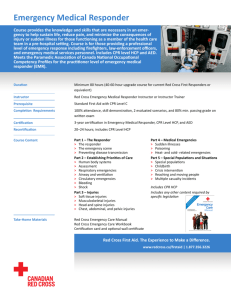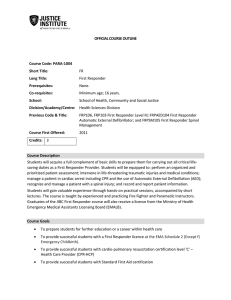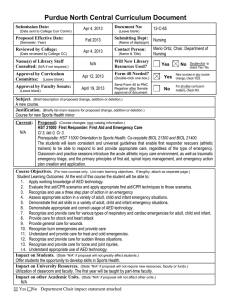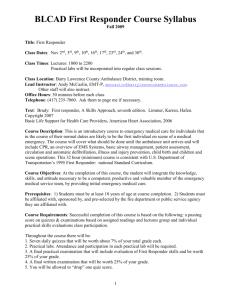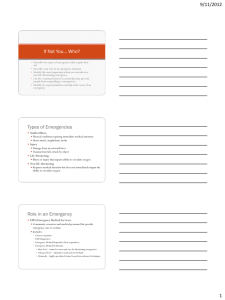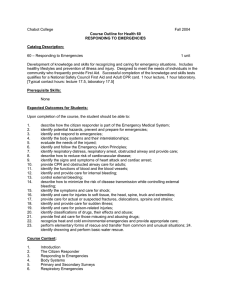Chabot College Fall 2004 – First Responder
advertisement
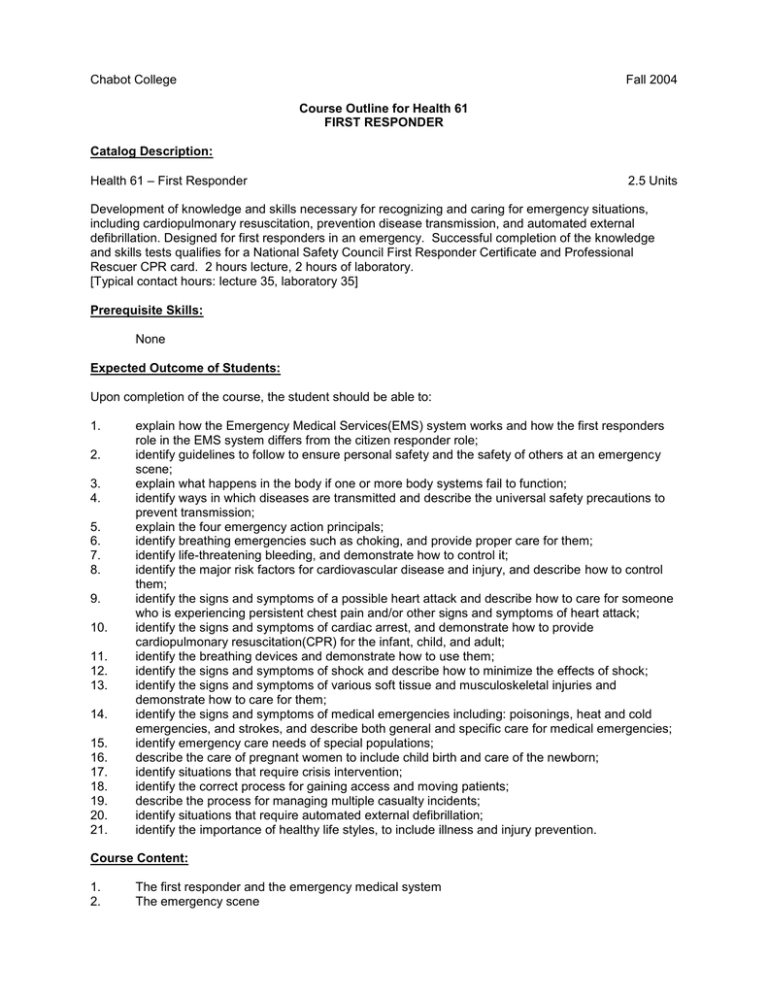
Chabot College Fall 2004 Course Outline for Health 61 FIRST RESPONDER Catalog Description: Health 61 – First Responder 2.5 Units Development of knowledge and skills necessary for recognizing and caring for emergency situations, including cardiopulmonary resuscitation, prevention disease transmission, and automated external defibrillation. Designed for first responders in an emergency. Successful completion of the knowledge and skills tests qualifies for a National Safety Council First Responder Certificate and Professional Rescuer CPR card. 2 hours lecture, 2 hours of laboratory. [Typical contact hours: lecture 35, laboratory 35] Prerequisite Skills: None Expected Outcome of Students: Upon completion of the course, the student should be able to: 1. 2. 3. 4. 5. 6. 7. 8. 9. 10. 11. 12. 13. 14. 15. 16. 17. 18. 19. 20. 21. explain how the Emergency Medical Services(EMS) system works and how the first responders role in the EMS system differs from the citizen responder role; identify guidelines to follow to ensure personal safety and the safety of others at an emergency scene; explain what happens in the body if one or more body systems fail to function; identify ways in which diseases are transmitted and describe the universal safety precautions to prevent transmission; explain the four emergency action principals; identify breathing emergencies such as choking, and provide proper care for them; identify life-threatening bleeding, and demonstrate how to control it; identify the major risk factors for cardiovascular disease and injury, and describe how to control them; identify the signs and symptoms of a possible heart attack and describe how to care for someone who is experiencing persistent chest pain and/or other signs and symptoms of heart attack; identify the signs and symptoms of cardiac arrest, and demonstrate how to provide cardiopulmonary resuscitation(CPR) for the infant, child, and adult; identify the breathing devices and demonstrate how to use them; identify the signs and symptoms of shock and describe how to minimize the effects of shock; identify the signs and symptoms of various soft tissue and musculoskeletal injuries and demonstrate how to care for them; identify the signs and symptoms of medical emergencies including: poisonings, heat and cold emergencies, and strokes, and describe both general and specific care for medical emergencies; identify emergency care needs of special populations; describe the care of pregnant women to include child birth and care of the newborn; identify situations that require crisis intervention; identify the correct process for gaining access and moving patients; describe the process for managing multiple casualty incidents; identify situations that require automated external defibrillation; identify the importance of healthy life styles, to include illness and injury prevention. Course Content: 1. 2. The first responder and the emergency medical system The emergency scene Chabot College Course Outline for Health 61, page 2 Fall 2004 3. 4. 5. 6. 7. 8. 9. 10. 11. 12. 13. 14. Human body systems Preventing disease transmission Establishing priorities of care; to include primary and secondary survey, respiratory emergencies, breathing adjuncts, cardiac emergencies, bleeding and shock Traumatic Injuries Medical emergencies Special situations to include pediatric patients, elderly patients, physically or mentally challenged patients Childbirth Crisis intervention to include specific emotional crisis, stages of grief, critical incident stress debriefing Reaching and moving patients Multi-casualty incidents Automated external defibrillation Healthy lifestyles and prevention of illness and injury Methods of Presentation: 1. 2. Lecture/discussion Skills demonstration Typical Assignments and Methods of Evaluating Student Progress: 1. Typical Assignments a. Move a patient using a stretcher b. Use the automated external defibrillator to defibrillate a “patient.” 2. Methods of Evaluating Student Progress a. Periodic quizzes b. Skills testing c. midterm and final Textbook(s)(typical) 1. 2. National Safety Council “First Responder,” Third Edition, Alton Thygerson, Jones & Bartlett Publishers, 2001 National Safety Council “First Responder Workbook,” Third Edition, Alton Thygerson, Jones & Bartlett Publishers, 2001 Special Student Materials: Adult face mask for CPR BP:al Revised: 10/15/03
